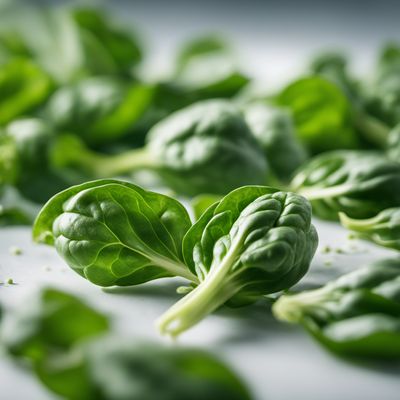
Ingredient
Oraches leaves
The Versatile Green: Oraches Leaves
Oraches leaves are leafy greens that have a mild, slightly salty taste and a tender yet crisp texture. They come in various colors, including green, red, and purple, and can be used as a substitute for spinach or lettuce in salads, soups, and stir-fries. These versatile leaves are a popular choice among chefs for their visual appeal and nutritional value.
Origins and history
Oraches leaves have a long history and are native to Europe and Asia. They were cultivated by the ancient Greeks and Romans, who used them both as a food source and for medicinal purposes. Today, oraches leaves are widely grown in many parts of the world and are enjoyed in a variety of cuisines.
Nutritional information
Oraches leaves are low in calories and fat, but rich in vitamins A, C, and K, as well as minerals like calcium and iron. They also contain antioxidants and fiber, making them a nutritious addition to any meal.
Allergens
None
How to select
When selecting oraches leaves, look for ones that are fresh and vibrant in color. Avoid leaves that are wilted, yellowed, or have brown spots. The leaves should be crisp and not limp. If possible, choose organic oraches leaves to ensure they are free from pesticides and other chemicals.
Storage recommendations
To keep oraches leaves fresh, remove any damaged or wilted leaves and store them in a plastic bag or container lined with a paper towel. Place them in the refrigerator and use within a week. Avoid washing the leaves until you are ready to use them, as excess moisture can cause them to spoil faster.
How to produce
Oraches leaves can be easily grown in home gardens or containers. They prefer well-drained soil and full sun or partial shade. Sow the seeds directly in the soil or start them indoors and transplant them once they have grown a few inches tall. Regular watering and occasional fertilization will help them thrive.
Preparation tips
Oraches leaves can be used in a variety of ways. They can be eaten raw in salads, sautéed with garlic and olive oil, or added to soups and stews. They can also be used as a substitute for spinach in recipes like spanakopita or quiche. The colorful leaves can be used to garnish dishes and add a pop of color.
Substitutions
Spinach, lettuce
Culinary uses
Oraches leaves are commonly used in Mediterranean and Asian cuisines. They are often used as a substitute for spinach or lettuce in salads, sandwiches, and wraps. They can also be cooked and used in stir-fries, pasta dishes, and omelettes.
Availability
Oraches leaves are cultivated in many regions around the world, including Europe, Asia, and North America. They are commonly found in farmers markets and specialty grocery stores.
More ingredients from this category

Amaranth leaves
The Nutrient Powerhouse: Exploring the Versatility of Amaranth Leaves

Spinaches
The Mighty Leafy Green

Cassava leaves
The Green Delight: Unveiling the Nutritional Powerhouse of Cassava Leaves

Garland chrysanthemums leaves
Edible Blossoms

Bitterleaves
The Bitter Beauty

Bitterblad leaves
The Bold and Bitter Bites: Exploring the World of Bitterblad Leaves

Sweet potato leaves
The Leafy Marvel

Black eyed peas leaves
Leafy Goodness

New Zealand spinaches
The Versatile Green Delight

Tannia leaves
The Versatile Tannia Leaves
